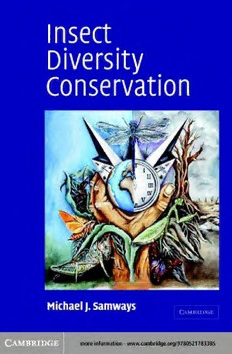
Insect diversity conservation PDF
Preview Insect diversity conservation
This page intentionally left blank Insect Diversity Conservation This groundbreaking book is an up-to-date global synthesis of the rapidly developing and important field of insect conservation biology. Insects are by far the most speciose organisms on earth, yet barely known. They play important roles in terrestrial ecological processes and in maintaining the world as we know it. They therefore present particular conservation chal- lenges, especially as a quarter may well become extinct in the next few decades. This book first addresses the ethical foundation of insect conservation, andaskswhyweshouldconcernourselveswithconservationofabutterfly, beetle or bug. The success of insects and their diversity, which have sur- vived the comings and goings of glaciers, is now facing a more formidable obstacle:themassiveimpactofhumans.Afteraddressingthreats,frominva- sive alien plants to global climate change, the book then explores ways in which insects and their habitats are prioritized, mapped, monitored and conserved. Landscape and species approaches are considered. Restoration, andtheroleofconventionsandsocialissuesarealsodiscussed.Thebookis for undergraduates, postgraduates, researchers and managers both in con- servation biology or entomology and in the wider biological and environ- mentalsciences. MICHAEL J. SAMWAYS is Professor of Entomology at the University of Stellenbosch, South Africa. He is internationally known as a conservation biologistandpolicyadvisor. Insect Diversity Conservation MICHAEL J. SAMWAYS UniversityofStellenbosch,SouthAfrica Cambridge, New York, Melbourne, Madrid, Cape Town, Singapore, São Paulo Cambridge University Press TheEdinburghBuilding,Cambridge,UK Published in the United States of America by Cambridge University Press, New York www.cambridge.org Information on this title: www.cambridg e.org /9780521783385 © Michael J. Samways 2005 Thisbookisincopyright.Subjecttostatutoryexceptionandtotheprovisionof relevant collective licensing agreements, no reproduction of any part may take place without the written permission of Cambridge University Press. Firstpublishedinprintformat 2005 - ---- eBook (NetLibrary) - --- eBook (NetLibrary) - ---- hardback - --- hardback - ---- paperback - --- paperback Cambridge University Press has no responsibility for the persistence or accuracy of sforexternalorthird-partyinternetwebsitesreferredtointhisbook,anddoesnot guaranteethatanycontentonsuchwebsitesis,orwillremain,accurateorappropriate. Contents Preface page ix Cover picture xi Part I The need for insect diversity conservation 1 1 Ethical foundation for insect conservation 3 1.1 Introduction 4 1.2 Environmental philosophy and insect conservation 4 1.3 Insect utility 9 1.4 Insect rights and species conservation 11 1.5 Spiritual conceptions 13 1.6 Summary 15 2 The special case of insects in conservation biology 16 2.1 Introduction 16 2.2 Insect radiation 18 2.3 Bauplan, flight and insect conservation 22 2.4 Polymorphisms 23 2.5 Insect diversity and the landscape 25 2.6 Global insect species richness 28 2.7 Survival in prehistorical times 29 2.8 Current extinctions 32 2.9 The taxonomic challenge 33 2.10 The perception challenge 35 2.11 Pest insects and population crashes 36 2.12 Summary 37 3 Insects and the conservation of ecosystem processes 39 3.1 Introduction 39 3.2 Insects as keystone organisms 40 3.3 Insect ecosystem engineers and soil modifiers 41 3.4 Insects as food for other animals 42 3.5 Insect dispersal 42 3.6 Insect pollinators 45 3.7 Insect herbivores 46 3.8 Insect parasitoids and predators 49 3.9 Insects and disease 50 v vi Contents 3.10 Ecosystem diversity and insect diversity 52 3.11 Insects and the naturally changing landscape 52 3.12 Significance of ecological connectance 53 3.13 Summary 54 Part II Insects and the changing world 57 4 Degradation and fragmentation of ecosystems 59 4.1 Introduction 59 4.2 Environmental contamination 61 4.3 Pesticides 63 4.4 Agriculture and afforestation 65 4.5 Urbanization and impact of structures 68 4.6 Deforestation and logging 73 4.7 Transformation of grasslands, savanna and Mediterranean-type ecosystems 78 4.8 Deterioration and loss of aquatic systems 80 4.9 Pressure on special systems 84 4.10 Overcollecting 86 4.11 Summary 87 5 Responses by insects to the changing land mosaic 89 5.1 Introduction 89 5.2 Behavioural responses 90 5.3 Population response and local extinction 98 5.4 Community response and long-term prognosis 100 5.5 Genetic changes 107 5.6 Summary 110 6 Threats from invasive aliens, biological control and genetic engineering 113 6.1 Introduction 114 6.2 Invasive alien plants 114 6.3 Invasive alien vertebrates 118 6.4 Invasive alien insects 119 6.5 Risks of introducing insect natural enemies 124 6.6 Risks of introducing insect pathogens 127 6.7 Risks of genetic engineering 130 6.8 Summary 134 7 Global climate change and synergistic impacts 136 Contents vii 7.1 Introduction 136 7.2 Ecosystem response to global climate change 137 7.3 Changes in species’geographical ranges 143 7.4 Synergisms and future perspectives 145 7.5 Summary 149 Part III Conserving and managing insect diversity 153 8 Methods, approaches and prioritization criteria 155 8.1 Introduction 155 8.2 Towards an ‘Earth ethic’ 156 8.3 Identifying geographical areas for conservation action 158 8.4 Systematic reserve selection 162 8.5 Use of surrogates in conservation planning 163 8.6 Coarse and fine filters 167 8.7 Plant surrogates 173 8.8 Animal surrogates 174 8.9 Phylogenetic considerations 175 8.10 Are ‘umbrella’and ‘flagship’species of value in conservation planning? 176 8.11 Summary 178 9 Mapping, inventorying and monitoring 180 9.1 Introduction 180 9.2 Mapping 181 9.3 Inventorying 186 9.4 Monitoring 192 9.5 Red Listing 195 9.6 Application of IUCN Red List Criteria at regional or national levels 198 9.7 Insects as bioindicators 199 9.8 Reference sites 203 9.9 Summary 203 10 Managing for insect diversity 206 10.1 Introduction 206 10.2 Importance of parks, reserves and remnant patches 207 10.3 Importance of landscape heterogeneity 212 10.4 Countryside-wide management 215 10.5 Importance of patch size relative to habitat quality 217 10.6 Simulating natural conditions and traditional practices 222 viii Contents 10.7 Corridors 226 10.8 Landscape management in urban areas 231 10.9 Summary 232 11 Restoration of insect diversity 234 11.1 Introduction 234 11.2 Principle of restoration triage 235 11.3 Restoration of species or processes? 237 11.4 Coarse-filter and fine-filter approaches to restoration 240 11.5 Insect gardening 244 11.6 Species-specific recovery plans 246 11.7 Summary 250 12 Conventions and social issues in insect diversity conservation 252 12.1 Introduction 252 12.2 The international arena 253 12.3 National issues 256 12.4 Overcoming the perception challenge 257 12.5 Butterfly houses and increasing conservation awareness 259 12.6 Deadstock trade 261 12.7 Butterfly farming 262 12.8 Summary 263 References 266 Index 316
